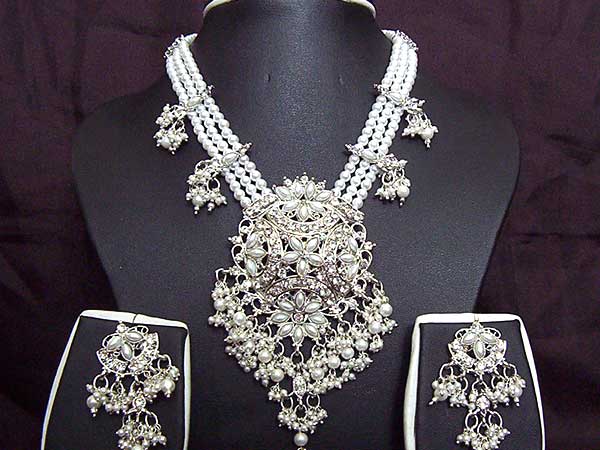The jewelry for an Indian bride comprises of a large number of items. With this article, explore the main types of Indian bridal jewelry.
Indian Bridal Jewelry

|
Jewelry forms a very important part of the overall attire of an Indian bride. In fact, the bridal look is believed to be incomplete unless the bride wears each and every piece of the jewelry meant for her. In majority of the Indian weddings, you will find the bride wearing yellow gold jewelry. However, depending on the budget, some people might opt for silver, platinum, white gold or diamond jewelry as well. Precious stones, such as ruby, jade, garnet, emerald, amethyst and pearl, are also widely used in Indian bridal jewelry. While you might see some variation in the bridal jewelry, depending on the particular region of the country where it is taking place, the basic items remain the same. Let us know more about the jewelry for an Indian bride.
Types Of Indian Bridal Jewelry
Shringar Patti
Shringar patti can be described as a kind of tiara, usually in gold, which adorns the forehead of the bride. It is placed along her hairline and has a circular plaque in the middle, which hangs below the hair line (on the forehead).
Maang Tikka
Maang Tikka can be said to be a shortened version of the shringaar patti. It comprises of a string, with a center piece attached to one end and a hook to the other. It is worn by the bride in center parting of the hair.
Bridal Set (Necklace & Earrings)
The outfit of a bride is incomplete without the bridal set, which comprises of a heavy neck piece, along with matching earrings. It is usually selected keeping in mind the color and overall style of the bridal dress.
Nath (Nose Ring)
Nath forms yet another important part of the bridal jewelry. It comprises of a studded nose ring, which has a long chain attached to it. The chain is hooked up in the hair of the bride, above the ear.
Chudi (Bangles)
Chudi (bangles), of gold as well as in glass, makes up a part of the overall jewelry worn by a bride. In some of the cases (like Punjabi weddings), the glass bangles are replaced by ivory ones, in red and white color (called chuda).
Hathphool (Bracelet with Rings)
Hathphool is a beautiful piece of jewelry that adorns the wrist as well as the fingers of the bride. It comprises of a bracelet, with one of the more strings attached to it, having rings(s) at the other end.
Anguthi (Finger Rings)
While wearing hathphool is not compulsory for a bride, anguthi surely is. Apart from the engagement ring, in the ring finger of her left hand, she wears one or more gold/diamond rings as well (in the other fingers).
Bichhua (Toe Ring)
An essential part of the bridal jewelry, in many states of India, bichhua comprises of a toe ring, usually in silver. It is also regarded as one of the signs of a married woman and is worn in pairs only.
Payal (Anklet)
Along with the toe ring, a bride is always required to wear payal, also known as pajeb, as a part of her wedding jewelry. It adorns the ankle of a bride, is made of silver (mostly) and has meenakari, kundan or beads as decorations.
Mangal Sutra (Necklace with Black Beads)
The most important part of the bridal jewelry is mangal sutra. However, it is not worn by the bride before the marriage. Rather, it is tied by her husband (around her neck), as symbol of their union. It comprises of a string of black beads, with a gold or diamond pendant.
Kamarband (Waist Band)
In the earlier times, the bride used to wear the kamarband around her waist. A heavy piece of jewelry, it was meant to support the wedding dress and keep in place. These days, it might or might not be worn by the bride.
Baaju Band (Arm Bands)
Baju band used to be a necessary part of the bridal jewelry, at one point of time in the past. However, these days, wearing it is optional. Some brides might wear one in each of the arms, while other may go for a single piece only.



